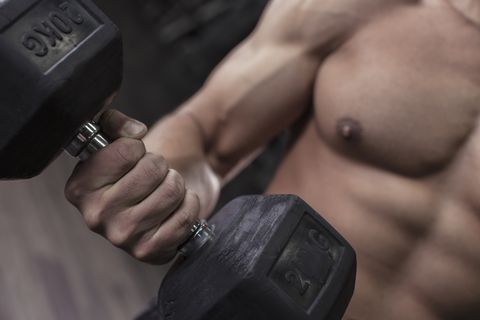
If you want to lift heavy weights, you’ve got to have a good grip.
Grip strength comes in three forms: crush, support, and pinch. Most of the research surrounding the benefits of having a strong grip relate to crush grip, which is the grip between your fingers and your palm used for grabbing ropes, bars, and shaking someone’s hand.
Training your grip can actually help you live longer, according to a 2015 Lancet study. Researchers tested nearly 140,000 people across the world on their grip strength using a dynamometer, a scientific tool used to measure grip force. The results showed that with every 5 kilogram decrease in grip strength, there was a 16 percent increased risk of all-cause death.
A University of Michigan study from earlier this year raised that number. The research team found that people with lower levels of muscle strength — strength gauged by grip strength tests — are 50 percent more likely to die earlier than individuals who are stronger than a baseline measurement.
Getting a (Stronger) Grip
So how strong is strong enough? If you’re reading this, you could probably do more to train your grip.
A 2016 Journal of Strength and Conditioning Research study established five health benefit zones in relation to handgrip strength for the US population: “needs improvement,” “fair,” “good,” “very good,” and “excellent.” Among adults aged 20 to 69, significantly more men (21 percent) than women (14 percent) were in the “needs improvement” category and more women (24 percent) than men were in the “excellent” category (15 percent). For both men and women, grip strength peaked at ages 30 to 39, with men in this age group having an average grip strength of 216 pounds in both hands and women showing an average strength of 136.5 pounds.
Everyone could benefit from stronger grips — but the study showed that men in particular could do with some collective improvements.
There are a plethora of standard strength training moves that work your grip – pullups, deadlifts, wrist curls, to name a few. Even if you’re an experienced lifter, however, you probably haven’t tried the following six exercises.
The Not-So-Typical Grip Strength Six
Tennis Ball Hand Clench
Equipment Needed: Tennis Ball
50 to 100 clenches per day
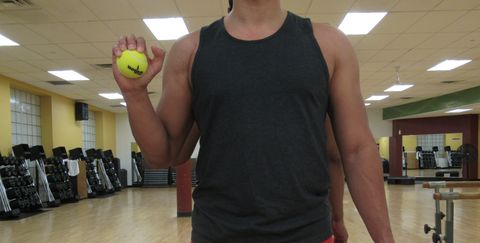
Mark Barroso
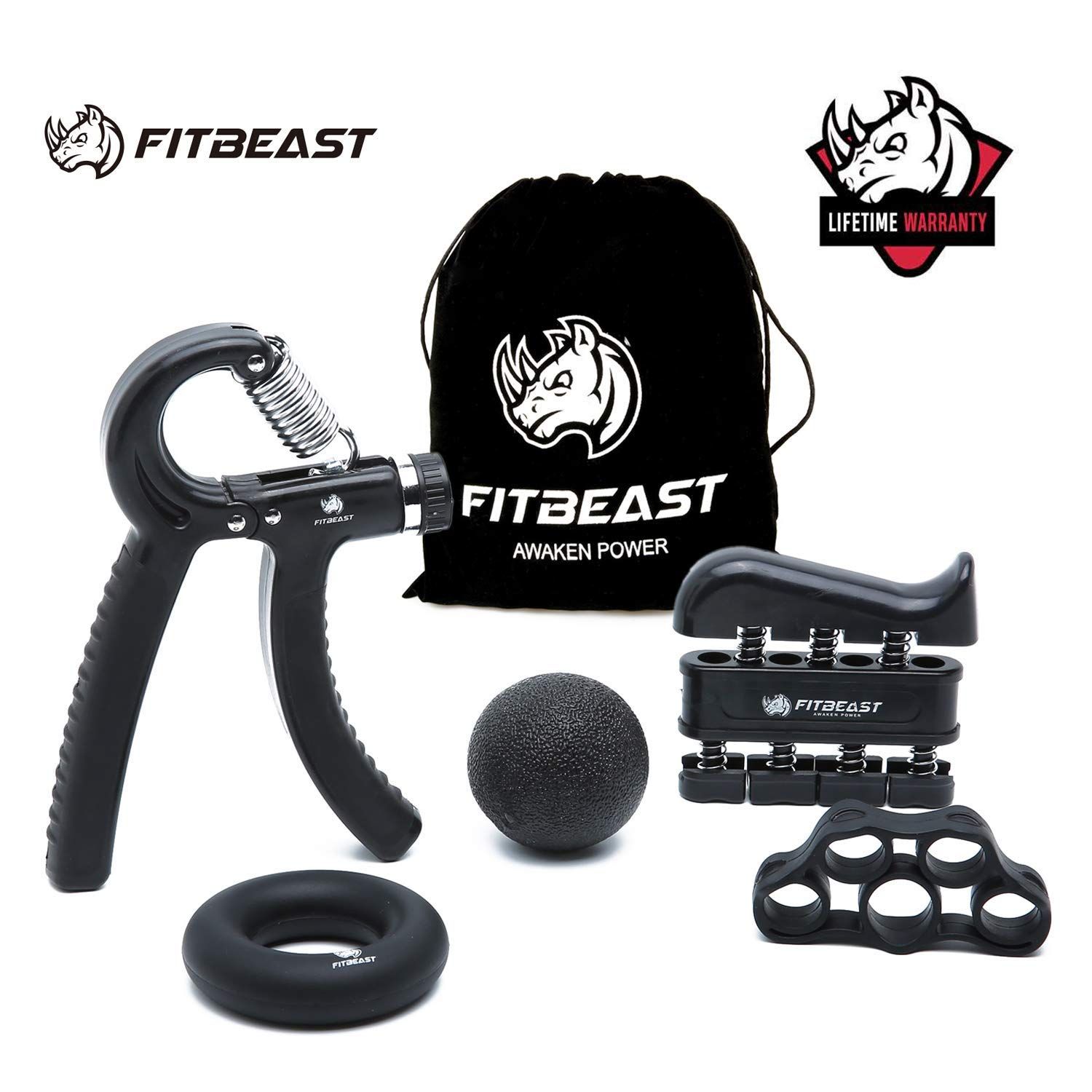
Do It: Stand or sit tall with your elbow fully flexed and your palm supinated, so it’s facing you. Grab a tennis ball and hold it in one hand using only your four fingers without the thumb. Squeeze the ball with the four fingers towards your palm. That’s one rep. Do 50 to 100 hand clenches per day, per hand, to improve grip strength.
Trainer Tip: If you have a spring-loaded grip strengthener or a stress ball, use that in addition to the tennis ball throughout the day. All of these techniques train crush grip.
Thick Grip Reverse Curl
Equipment Needed: Two dumbbells, diameter-thickening device
3 sets of 8 reps
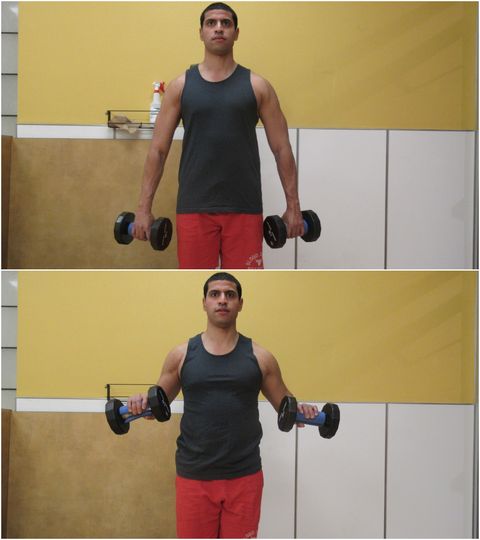
Mark Barroso
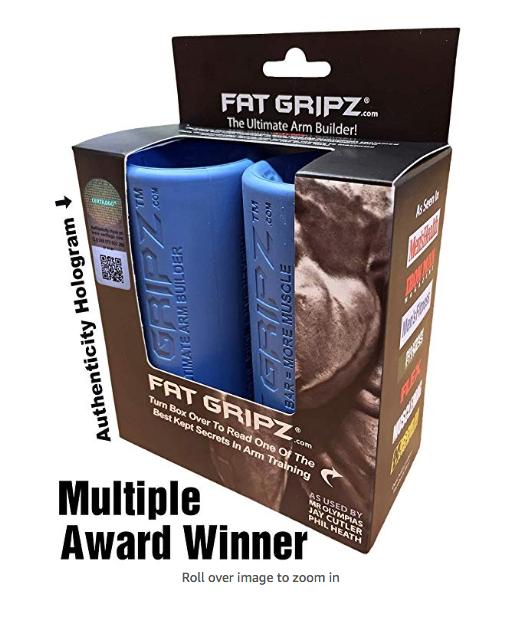
$29.00
SHOP NOW
How to Do It: Before you start, place a diameter-thickening device over the handles of two dumbbells. Stand facing forward with feet shoulder-width apart and back straight. Grab the dumbbells with an overhand (pronated) grip and place your arms straight down at your sides.
Keeping the hands pronated, squeeze your biceps and forearms to bring the dumbbells toward your chin in a slow, controlled manner. Pause for three seconds at the top, then release the weights slowly back to the starting position. That’s one rep.
Trainer Tip: Fat grips help to build crush grip, which transfers to sports performance, according to a recent Journal of Strength and Conditioning study. By pronating at the radioulnar joint (meeting of radius and ulna arm bones) in the reverse curl, you activate the forearm extensors (which open the hand) as well as the brachialadoris (lower arm muscles) rather than just the biceps brachii (the peak) during a regular curl.
Towel Plate Farmer’s Carry
Equipment Needed: two medium sized towels, two weight plates
3 rounds of 20 to 30 yard carries
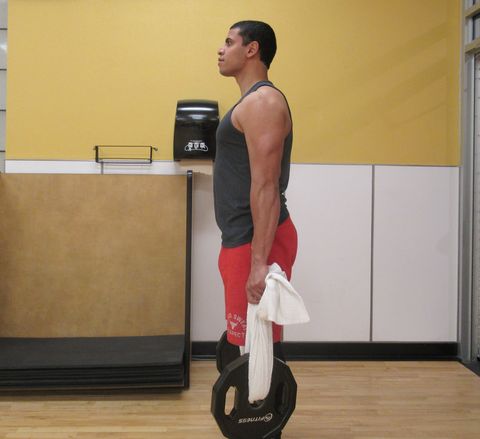
Mark Barroso
How to Do It: Loop the towels through the holes in the center of each weight plate. Stand holding both ends of each towel in each hand. Make sure that your towels are long enough so that the weight doesn’t hit the ground while holding them at your sides.
Walk forward 20 to 30 yards, turn around, then walk the back to the starting position. Repeat for 3 total trips.
Trainer Tip: Farmer’s carries train the crush and support grip, which is a static grip that requires your forearms and hands to maintain a hold for an extended period of time. Using the towels as your gripping mechanism places increases emphasis on the forearms.
Plate Raise and Transfer
Equipment Needed: Weight plate
3 sets of 5 reps in each direction

Mark Barroso
How to Do It: Place a 10 pound plate on the ground. Stand tall with knees slightly bent and back straight. Bend your knees and grab the plate using only your fingertips — your thumb should be on one side of the plate, with your other four fingers on the other side. Stand up with the weight “pinched” like this so it’s next to your right hip with both arms at your sides.
For the transfer, raise the plate with your right hand in front of your face at eye level. Next, transfer by pinching it with the same way with your left hand, then bring the weight to the left side of your body. That’s one rep from right to left.
Trainer Tip: Pinch grip is the grip between your fingers and your thumb which assist in throwing, rock climbing, sandbag carries and holding onto an object “just barely by a thread.” Developing this type of grip helps the other types of grip and helps you pick up odd objects with just your fingertips.
Bucket Carry
Equipment Needed: Five-gallon plastic bucket with weights (kettlebell, dumbbell, sandbag, sand, or rocks)
4 trips of 50 yards
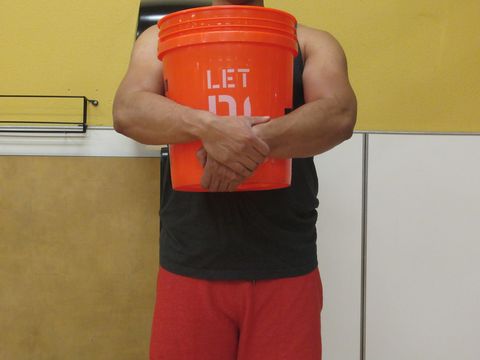
Mark Barroso
How to Do It: Fill the bucket 70 to 80 percent full if you’re using actual sand or rocks — otherwise, place 50 to 60 pounds worth of weights in the bucket. Once filled, grip the bucket with one hand underneath its bottom and the other hand grabbing the opposite wrist.
Keep the bucket high and tight to your chest. Walk 50 yards forward, turn around and walk 50 yards back. That’s one trip. Do four total trips.
Trainer Tip: Switch back and forth between which hand is grasping the bucket after each trip so you don’t burn one side out too quickly. If you need to place the bucket down, don’t just let it go; do a quarter lunge, place the bucket on top of your front thigh and rest for 30 to 60 seconds.
Rope Inverted Row
Equipment Needed: Climbing rope (17 feet long, 1-inch inch thick) and a sturdy overhead anchor.
3 sets of 8 reps
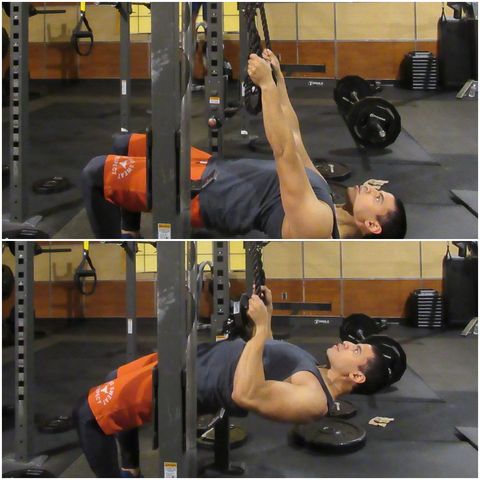
Mark Barroso
How to Do It: Loop one end of the rope around the anchor (a pullup bar should work), making sure that both ends are even. Grab each end of the rope in each hand with 1 to 2 feet of slack underneath. Now, position yourself underneath the pullup bar so your knees are bent and your back is parallel to the ground. Your arms should be straight.
Keeping a flat back, bend your elbows, squeeze your back, and row yourself toward the ceiling. Hold for a count, then return back to the starting position. That’s one rep.
Trainer Tip: This move works crush grip and support grip in addition to the back and abdominal muscles.
Source: Read Full Article
